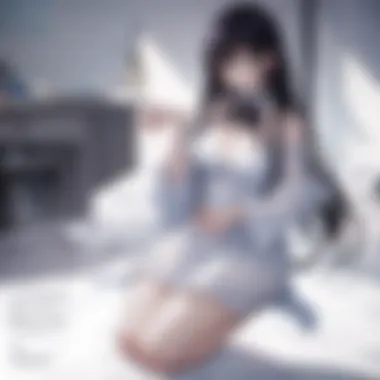Exploring the Essence of 'Love So Pure' in Manga


Intro
Pure love is a fundamental theme in many art forms. In manga, its expressions often encapsulate deep emotional connections and profound character interactions. This exploration of 'love so pure' delves into the character profiles that embody this theme, the cultural implications behind these relationships, and the series that highlight these dynamics.
Character Profiles
Overview of Main Characters
In the realm of manga, main characters often serve as vessels for exploring complex themes such as love. The protagonists typically embody idealized notions of romance, purity, and emotional depth. For instance, in "Your Lie in April," the character Kousei Arima navigates grief and love through his relationship with Kaori Miyazono. Their connection is fraught with challenges, yet it illustrates the beauty and transience of pure love.
Another notable example is Touko Nanami from "Tsuki ga Kirei." Her character provides a glimpse into adolescent relationships, reflecting the innocence and complexity that comes with young love. Each character behaves in ways that resonate with readers, showcasing what it means to truly care for someone else.
Supporting Characters
Supporting characters play an equally crucial role in emphasizing the theme of pure love. These characters often serve as emotional anchors or catalysts for the protagonists’ growth. In "Fruits Basket," characters like Hatori Sohma offer insight into the struggles of love and sacrifice, enhancing the narrative through their experiences.
Moreover, the depth of supporting casts can elevate the theme, drawing contrasts and supporting the main characters’ journeys towards understanding love. The interactions among characters, no matter how minor, enrich the storytelling and reinforce the narrative's emotional weight.
Theme Exploration
Central Themes
The prevalence of love in manga often intertwines with themes of sacrifice, longing, and fidelity. These dimensions contribute to a compelling narrative structure that drives character development. A series like "Sword Art Online" explores virtual reality as a metaphor for longing and connection. Kirito’s relationships are not simply romantic but encompass friendship and loyalty, revealing the broader dimensions of love beyond just the couple.
Cultural References
Japanese culture profoundly influences the portrayal of love in manga. Concepts such as "wa" (harmony) and "mono no aware" (the beauty of transient things) resonate through many stories. These cultural references shape character behaviors and interactions, highlighting how societal norms around love can vary. For instance, the examination of unrequited love in "Ao Haru Ride" reflects societal pressures faced by youth, creating a relatable yet poignant narrative.
"In manga, pure love often reflects cultural values, encapsulating emotional journeys that transcend mere affection."
Popular Series and Recommendations
Top Anime Series of the Year
Each year, certain series capture the essence of pure love in unique ways. Some notable titles include:
- "Jujutsu Kaisen" - While primarily an action series, underlying themes of camaraderie and sacrifice emphasize the deep bonds between characters.
- "Call of the Night" - A fresh take on romance that explores the nuances of love amidst a supernatural backdrop.
- "Oshi no Ko" - This series examines the intersection of love and ambition within the entertainment industry.
Hidden Gems in Manga
Apart from mainstream series, some hidden gems provide profound insights into pure love:
- "Let’s Dance a Waltz" - A heartwarming exploration of love through dance, revealing personal growth.
- "Kimi wa Petto" - This narrative offers a unique take on love, blurring lines between companionship and romance.
Exploring these works provides a deeper understanding of how ‘love so pure’ is portrayed within the medium of manga. This intricate relationship between characters and love not only nourishes the story but also enriches reader experiences, serving as a powerful conduit for personal reflection and cultural appreciation.
Understanding Pure Love in the Context of Manga
Understanding the essence of pure love in manga is crucial for grasping the thematic richness that this genre offers. Pure love has the power to evoke emotions, create suspense, and deepen character development. It serves as a lens through which readers can explore the complexities of human relationships in an accessible format. As manga often reflects societal norms and aspirations, the portrayal of pure love resonates with audiences, reinforcing their values and understanding of romance.


In this section, we will outline specific elements that define pure love in manga as well as its historical and cultural significance. This investigation helps demystify the interactions between characters and the broader themes of emotional connection that permeate storytelling.
Defining Pure Love
Pure love can be described as an idealized form of affection characterized by selflessness, loyalty, and profound emotional connection. It transcends mere physical attraction, delving into the emotional spectrum of human relationships. In manga, pure love often manifests in various forms, including familial love, platonic bonds, and romantic partnerships. Each form contains unique nuances that contribute to character growth and narrative progression.
Historical Context of Love Themes in Manga
The portrayal of love in manga has evolved significantly over the decades. Initially, love stories were influenced by traditional values and gender roles that dictated how relationships should function. Early manga depicted love in a somewhat simplistic manner, often focusing on societal norms and expectations. Over time, different genres emerged, offering a diverse range of perspectives on love. The shift toward more complex relationships reflects changing cultural attitudes and a greater acceptance of various forms of love. The rise of shōjo and shōnen manga introduced more varied expressions of love, allowing for deeper emotional connections and exploring themes such as heartbreak, sacrifice, and growth.
Cultural Significance of Love in Japanese Society
In Japanese culture, love is depicted not only as a personal emotion but also as a communal and societal value. The significance of love extends beyond the individual, serving as a pillar for family and community structures. Love in manga often mirrors real-life expectations, showcasing how relationships can support or challenge personal aspirations. Moreover, love stories resonate with the ideals of simplicity and purity, often emphasizing emotional sincerity over material pursuits. This cultural backdrop shapes the portrayal of love in manga, providing a rich context for understanding its importance.
Key Elements of Pure Love Depicted in Manga
The theme of pure love is essential in manga, as it shapes not only character interactions but also the overarching narratives that resonate with readers. Understanding the key elements that depict pure love allows enthusiasts to appreciate the depth of storytelling that manga can offer. Each critical aspect contributes to how characters grow and how their relationships unfold, creating memorable experiences for audiences. This section delves into three significant elements of pure love: character dynamics, conflict resolution, and symbolism.
Character Dynamics and Relationships
Character dynamics are central to portraying pure love in manga. The interactions between characters often illustrate the subtleties of their feelings. Different types of relationships emerge, such as friendships evolving into romantic connections or struggles between love and personal ambition. These dynamics often reveal the complexity of emotional intimacy and highlight the individuality of each character.
The significance of character development cannot be understated. Characters must evolve to confront their feelings and navigate the challenges they face. For instance, in Your Lie in April, Kousei’s journey of self-discovery is intertwined with his relationship with Kaori. This creates a rich narrative that emphasizes vulnerability and healing through love.
Conflict and Resolution in Love Stories
Conflict plays a crucial role in love stories, acting as a catalyst for growth. Pure love does not simply exist in a vacuum; it is often depicted through trials and tribulations that challenge the characters involved. This conflict may arise from external circumstances such as societal expectations or personal struggles. In other situations, it can manifest as internal conflicts, where characters wrestle with their self-doubt or past traumas.
The resolution of conflicts often portrays the essence of pure love. A compelling love story typically shows how characters overcome their challenges and grow closer in the process. In Toradora!, for instance, the complexities of relationships and misunderstandings provide a backdrop for the characters' emotional maturation. Ultimately, the resolution often reinforces the notion that love can prevail even in the face of adversity.
Symbolism and Imagery Related to Love
Symbolism enriches the themes of pure love in manga, helping to underscore key emotions and moments in the story. Various symbols, such as cherry blossoms or rain, represent fleeting beauty and the transience of relationships. These images allow readers to connect on a deeper level, evoking specific feelings tied to the depiction of love.
Furthermore, visual imagery plays a tactical role in conveying emotional depth. The art style, color palettes, and panel layouts can express the intensity of feelings. A sudden change in color, for example, can signify a shift from joy to sadness, embodying the rollercoaster of emotions that love brings. This intricacy in design helps the audience engage more profoundly with the narrative.
In summary, the key elements of pure love depicted in manga provide a framework for understanding its impact on relationships. Character dynamics enhance the emotional landscape, while conflict and resolution showcase growth and depth. Symbolism and imagery create a rich tapestry that resonates on multiple levels, making the exploration of love in manga not only appealing but also reflective of the complexities of human emotions.
Notable Manga Titles Exploring Pure Love
In examining the theme of pure love, it is essential to look at notable manga titles that portray this concept effectively. These works not only enhance the understanding of love within the medium but also illustrate how intricate narratives, character development, and emotional depth can resonate profoundly with readers. The exploration of these titles sheds light on varying aspects of love that are relevant to cultural, social, and personal contexts, thereby reinforcing the significance of pure love in Japanese manga.
Analysis of 'Your Lie in April'
'Your Lie in April' stands out for its poignant depiction of love intertwined with loss and growth. The story follows Kousei Arima, a piano prodigy who experiences a traumatic event that deters him from playing music. His journey of rediscovery is catalyzed by the vibrant Kaori Miyazono, a free-spirited violinist. The manga presents love not merely as romantic attraction, but as a transformative force that encourages self-discovery. The emotional weight of their relationship is felt through Kousei's internal battles and Kaori's tragic fate, blending joy and sorrow in a seamless narrative.
In terms of artistic portrayal, the use of music as symbolism amplifies the characters' emotions. The interplay between the graphical representation of musical notes and emotional expressions illustrates the depth of their feelings, creating a rich visual experience that echoes the theme of pure, albeit complex, love. This manga ultimately serves as a reminder of how love can inspire and challenge individuals to confront their fears and heartaches.
Exploring 'Ao Haru Ride'
'Ao Haru Ride' explores the notion of first love and its lingering impact on personal growth. The story centers around Yoshiko Usami and her feelings for her first crush, who reappears in her high school life after a transformative gap. This manga captures the bittersweet essence of nostalgia and the realities of young love navigating through adolescence. The character dynamics are nuanced, highlighting the importance of communication in relationships.


Moreover, 'Ao Haru Ride' presents relatable experiences, such as the struggle of unrequited feelings and self-acceptance. The authenticity of the characters allows readers to engage with their emotional journeys. The evolution of Yoshiko’s character from uncertainty to confidence illustrates how love can encourage individuals to embrace their authentic selves and cultivate their aspirations.
Themes in 'Fruits Basket'
'Fruits Basket' delves into the complexities of love within family dynamics and friendship. The central character, Tohru Honda, becomes intertwined with the cursed Sohma family, whose members transform into animals from the Chinese zodiac. The themes of love, acceptance, and healing are woven throughout Tohru’s interactions with the Sohma family members. Her unconditional support and empathy break down the barriers formed by their individual hardships.
The narrative emphasizes that pure love extends beyond romantic relationships; it encompasses platonic love and familial bonds. This manga illustrates how understanding and compassion can lead to emotional healing. Tohru's influence on the Sohmas reaffirms the transformative power of love, as they learn to confront their past traumas and foster connections with one another.
The Impact of 'Toradora!'
'Toradora!' is notable for its intricate portrayal of the misadventures associated with high school love. The story follows Ryuuji Takasu and Taiga Aisaka, two seemingly incompatible individuals whose paths converge amidst their shared struggles. The manga highlights themes of love that combine humor with emotional depth. It explores how love can be messy, filled with misunderstandings and complexities.
The character development in 'Toradora!' stands out, as both Ryuuji and Taiga evolve significantly throughout the story. Their budding relationship, rooted in friendship and mutual support, illustrates how love can be an exploration of personal identity. The manga's resolution offers a satisfying conclusion, emphasizing growth through connection and shared experiences.
Narrative Techniques Used to Convey Pure Love
The portrayal of pure love in manga is intricately woven through various narrative techniques. These methods serve not only to tell a story but also to deepen the emotional connections between characters. By focusing on specific elements like dialogue, art style, and pacing, manga creators are able to convey the nuances of love effectively, allowing readers to immerse themselves in the narratives.
Dialogue as a Tool for Emotional Depth
Dialogue plays a significant role in expressing the emotions of characters. It can reveal their thoughts, fears, and desires. In many manga, the conversations between characters are carefully crafted to convey their feelings without the need for excessive exposition. For instance, the use of silence or short exchanges can indicate tension or longing, making the moments more poignant. Often, what is not said can be as powerful as the spoken words.
Emotional depth is enhanced by using specific phrases that resonate with readers. Writers often employ a mix of formal and informal speech to reflect the characters’ relationships and social dynamics. Additionally, the use of inner monologues allows readers to understand characters' internal struggles. This technique draws the audience deeper into the emotional experiences of the characters and fosters empathy.
Art Style and its Influence on Perception of Love
Art style significantly shapes the way love is perceived in manga. Various styles—from minimalist designs to intricate illustrations—affect how readers interpret the feelings and relationships between characters. For example, soft colors and gentle lines often depict tender moments, while bold strokes and vibrant colors may illustrate intense emotions.
Character designs also play a crucial role. Exaggerated facial expressions can effectively communicate love, shock, or sadness, allowing readers to grasp the emotional context quickly. Additionally, backgrounds can set the atmosphere for love scenes. An empty park or a bustling street intensifies the feelings shared between characters, emphasizing their isolation or connection amid the chaos.
Pacing and Timing in Love Stories
Pacing is essential in developing a romance narrative. The rhythm of the story influences how love unfolds over time. A slow build-up creates anticipation and allows readers to invest in the characters’ journeys. Key moments, like a first confession or a heart-wrenching farewell, are often punctuated with careful timing to maximize their impact.
Flashbacks can be used effectively to provide context, enriching the current emotional stakes. By revisiting past moments, the audience gains insight into why characters act or feel a certain way in the present. Moreover, the juxtaposition of fast-paced incidents with slower, reflective moments creates a dynamic flow that keeps the reader engaged while emphasizing the significance of love in the storyline.
"Narrative techniques in manga not only express love but also build the emotional landscape that surrounds it."
Audience Reception of Pure Love Themes
The reception of pure love themes in manga plays a pivotal role in shaping not just the narratives, but also the cultural landscape surrounding these works. This theme resonates deeply with readers, often reflecting their own experiences and aspirations regarding love. By examining this subject, one can uncover layers of emotional engagement that influence acceptance and popularity within the manga community.
Notably, pure love motifs invoke a spectrum of feelings among readers. It creates a shared bond based on empathy and understanding. As manga captures the idealization of relationships, readers often find themselves immersed in the emotional rollercoaster that characters undergo. This immersion may cultivate a sense of nostalgia or longing, fueling discussions and interpretations that enliven the community itself.
Emotional Impact on Readers
The emotional impact of pure love themes cannot be understated. Manga such as "Your Lie in April" and "Fruits Basket" evoke poignant feelings, portraying love not merely as joy but as a complex interplay of happiness and sorrow. Readers often connect deeply with the characters, experiencing their joys and pains almost as if they were living through them.
This visceral connection supports emotional catharsis. By engaging with these narratives, readers can reflect on their own lives and relationships. The themes often transcend age and gender, creating a universal appeal that resonates with a broad audience base. Such deep emotional involvement helps to solidify a loyal readership that actively seeks out similar stories.
Consumer Trends in Romance Manga


Analyzing consumer trends in the romance manga genre reveals substantial shifts toward pure love narratives. Trends indicate an increasing desire for authenticity in character relationships. Modern audiences favor stories that blend realism with idealism, which is indicative of contemporary cultural values. As more readers gravitate towards works like "Ao Haru Ride," which portray relatable love stories, publishers respond by investing more in these themes.
In addition to this, the rise of digital platforms has transformed how consumers engage with romance manga. Readers have greater access to serialized stories online, allowing for community discussions that shape their reading choices. Hence, the demand for pure love stories goes hand-in-hand with the ease of access to diverse titles.
Community Discussions Focused on Love Themes
Community discussions often center around interpretations of love embodied in various manga series. Websites like reddit.com serve as platforms for fans to exchange ideas, theories, and critiques surrounding specific titles. These discussions enhance community engagement and deepen the understanding of the nuances within different love stories.
Members of these communities bring a multitude of perspectives, allowing enthusiasts to delve into the psychological and social underpinnings of love portrayed in manga. The dialogue surrounding these themes also helps in shaping future narratives. Fans often discuss their favorite moments or the emotional impact of specific chapters, influencing both creators and the industry in terms of what resonates most with audiences. In summary, the audience reception of pure love themes illuminates the intricate relationship between readers and manga, emphasizing emotional resonance, trends, and communal discourse.
Pure Love Beyond the Page: Cultural Effects
The theme of pure love in manga resonates far beyond the pages of its storylines. It invariably shapes perceptions and influences cultural paradigms within Japanese society and beyond. This section highlights the significant effects that pure love narratives have on pop culture, adaptations, and merchandise, emphasizing their overarching impact.
Influence on Japanese Pop Culture
Manga has become a vital part of Japanese pop culture, with pure love themes at its core. These narratives often reflect societal ideals and aspirations around relationships, making them relatable for many. The portrayal of love in manga often transcends mere romantic interest. It embodies emotional connections that resonate with readers on a personal level. This connection can ignite fandoms that engage with these themes profoundly.
Furthermore, pure love stories often inspire various forms of media. They set trends not just in literature, but also in music, movies, and fashion. Through these various formats, the concept of pure love continues to evolve, affecting how younger generations conceptualize relationships. Media outlets often highlight these themes as representations of hope, dreams, and the complexities of human emotions.
Adaptations of Manga into Other Media
The journey of manga stories often extends into realms beyond print. Notably, adaptations into anime and live-action films have brought love stories to wider audiences. These adaptations maintain the narrative's core essence while employing different artistic styles. They attract viewers who may not have engaged with the printed form originally.
Adaptations also offer opportunities for deeper exploration of character dynamics that were briefly touched upon in the manga. The voice acting and visual storytelling in anime adaptations can enrich the way audiences connect with characters and their experiences of love. This layered exposure can drive demand for original manga, creating a cyclical effect in the popularity of pure love narratives.
Merchandising and Pure Love Motifs
Merchandising is another significant aspect of the cultural effects arising from pure love in manga. From figures to art books and apparel, products often reflect themes seen in beloved narratives. Fans might purchase figurines of their favorite characters holding symbolic items or wearing outfits that encapsulate the essence of their romantic journeys.
These products serve not only as collectibles but also as conduits for emotional expression. They allow fans to incorporate elements of their favorite stories into their daily lives, reinforcing the connection to the themes of pure love. Moreover, events like anime conventions showcase a plethora of merchandise, creating spaces for fans to celebrate these stories together in community settings.
Thus, the influence of pure love narratives in manga extends to various facets of modern culture, making it an important element to understand. Through exploration of pop culture, media adaptations, and merchandising, readers can grasp why these themes matter and how they continue to impact societal views on love and relationships.
Future Directions in Manga Relationships
The realm of manga is evolving rapidly, especially concerning how relationships are portrayed. The future directions in manga relationships are essential to understand as they reflect changing societal norms and audience expectations. Themes of romance and love are being explored more deeply, with complex characters and multifaceted relationships. This section discusses emerging trends, the role of digital formats, and changing audience expectations, providing insights into how these elements will shape the future of romance in manga.
Emerging Trends in Romance Manga
Romance manga is witnessing several interesting developments. One key trend is the increased representation of diverse relationships. This includes greater visibility for LGBTQ+ characters and plots that challenge traditional romantic frameworks. Stories now often explore non-conventional relationships, delving into aspects such as polyamory and platonic love.
Another phenomenon is the blending of genres, where romance elements are integrated with fantasy, science fiction, and horror. This fusion allows for unique narrative possibilities, challenging the norms of relationship portrayals.
Additionally, slice-of-life stories that depict everyday romantic interactions are gaining popularity. Readers are drawn toward realistic explorations of love, illustrating how relationships develop in mundane scenarios. This trend offers relatable content that resonates with audiences on a personal level.
The Role of Digital Formats and Accessibility
Digital formats are redefining how manga is consumed. Platforms like Crunchyroll and ComiXology make manga accessible to wider audiences beyond geographical constraints. This accessibility fosters a more inclusive environment where diverse stories can thrive. Digital-first series often experiment with format, mixing animations, sound, and interactivity.
Such changes affect how romance is conveyed. The absence of physical limitations allows for innovative storytelling techniques. In addition, social media platforms enable authors to share their work more directly, establishing a connection with their audience. Popularity on platforms can significantly influence future projects, guiding creators toward elements that resonate with readers.
Changing Audience Expectations for Love Stories
As society evolves, so do the expectations of manga readers. Audiences are increasingly looking for authenticity in romance narratives. The simplification of traditional tropes is becoming common. Readers prefer complex characters faced with realistic dilemmas that reflect modern life. This pushes authors to create narratives that move away from idealized versions of love.
Moreover, engagement with social issues such as mental health, self-acceptance, and personal growth is becoming a norm. These themes often intertwine with romantic plots, adding layers of depth.





